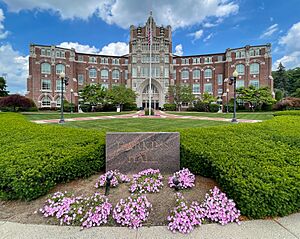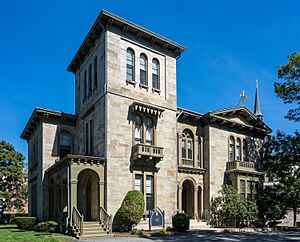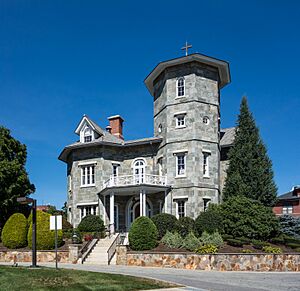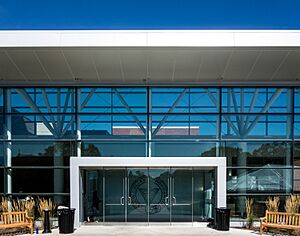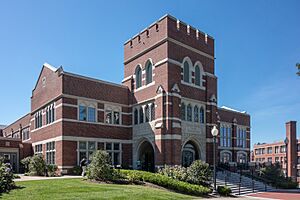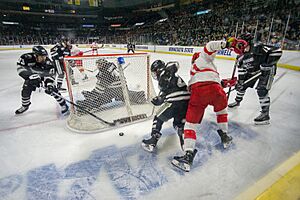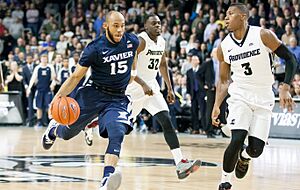Providence College facts for kids
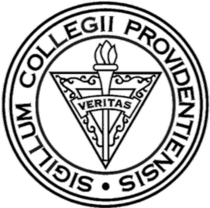 |
|
| Motto | Veritas |
|---|---|
|
Motto in English
|
Truth |
| Type | Private university |
| Established | 1917 |
| Accreditation | NECHE |
|
Religious affiliation
|
Catholic (Dominican) |
|
Academic affiliations
|
ACCU NAICU Space-grant |
| Endowment | $234 million (2019) |
| President | Kenneth R. Sicard |
|
Academic staff
|
310 full-time ordinary 28 Dominican Friars and Sisters |
| Students | 4,816 (Spring 2021) |
| Undergraduates | 4,363 (Fall 2023) |
| Postgraduates | 688 (Spring 2021) |
| Location |
,
Rhode Island
,
United States
41°50′38″N 71°26′06″W / 41.84389°N 71.43500°W |
| Campus | Urban; 105 acres (.425 km2) |
| Colors | Providence Black, Pantone Metallic 877, and White |
| Nickname | Friars |
|
Sporting affiliations
|
|
| Mascot |
|
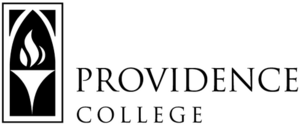 |
|
Providence College is a private Catholic university. It is located in Providence, Rhode Island, United States. The Dominican Order and the Roman Catholic Diocese of Providence started the college in 1917. Students can choose from 47 different main subjects and 17 advanced study programs.
All undergraduate students must take 16 credits in a program called "Development of Western Civilization." This is a big part of the college's main courses. In spring 2021, there were 4,128 undergraduate students. There were also 688 graduate students, making a total of 4,816 students.
In sports, Providence College teams are called the Providence Friars. They compete in NCAA Division I. The college was a founding member of the original Big East Conference. It is also part of Hockey East. In 2013, the college joined other Catholic schools to form the current Big East Conference.
Contents
- Discovering Providence College's History
- Exploring the Providence College Campus
- How Providence College is Managed
- Learning at Providence College
- Student Life at Providence College
- Providence College Sports Teams
- College Symbols and Seals
- Famous People Who Went to Providence College
- Images for kids
- See also
Discovering Providence College's History
How Providence College Began
Providence College started in 1917 as a school for men. The Roman Catholic Diocese of Providence and the Dominican Province of St. Joseph worked together to create it. Bishop Matthew Harkins wanted a place for Catholic young people in Rhode Island to get a good education.
The college opened with just one building, Harkins Hall. Dennis Albert Casey, O.P., was the first president (1917–1921). There were 71 students and nine Dominican teachers. Under the second president, William D. Noon, O.P. (1921–1927), the college hired its first non-religious teacher. It also opened its first dorm, Guzman Hall (now Martin Hall).
During President Lorenzo C. McCarthy, O.P.'s time (1927–1936), the college's sports teams got their nickname, the "Friars." Their team colors were black and white. The school had early success in basketball, football, and baseball. In 1933, the college became officially recognized by the New England Association of Schools and Colleges. By 1935, the college started giving out advanced degrees. That same year, the school newspaper, The Cowl, was first published.
Fundraising during World War II helped the campus grow. Even famous people helped. In 1938, a young film star named Judy Garland sold autographs to raise money for a new building.
By 1939, Aquinas Hall dormitory was built for more students. During World War II, fewer students enrolled. President John J. Dillon, O.P. (1936–1944) asked the government for help. The college then hosted an Army Specialized Training Program unit. About 380 soldiers studied engineering there for a year before going overseas. This helped the college stay open.
Growing After World War II
Robert J. Slavin, O.P., was president from 1947 to 1961. In 1955, Providence College bought more land. This expanded the campus to Huxley Avenue. Slavin also helped start the Reserve Officers' Training Corps (ROTC) in 1951. The Liberal Arts Honors Program began in 1957.
The college's sports program joined the National Collegiate Athletic Association (NCAA) in 1948. Before Alumni Hall gymnasium opened in 1955, the men's basketball team played in local high schools. The college hired Joe Mullaney as the men's basketball coach.
President Vincent C. Dore, O.P. (1961–1965) opened the college's graduate school. A new dorm, now called Meagher Hall, also opened. President William P. Haas, O.P. (1965–1971) opened Phillips Memorial Library in 1969.
Welcoming Female Students
In 1967, the college hired its first non-religious teachers in Theology and Philosophy. It also hired its first full-time female teacher. Two years later, the student dress code was removed. In 1970, the college decided to admit women. Female students started attending in the 1971–1972 school year. The first female administrator was hired that same year. By 1975, women were taking on important roles in student groups. Anne Martha Frank was the first woman to edit The Cowl, the college newspaper. Patricia Slonina became the first woman editor of the literary magazine, The Alembic. Ana Margarita Cabrera was the first woman to edit the school yearbook, The Veritas.
President Thomas R. Peterson, O.P. (1971–1985) started the Development of Western Civilization program. In 1974, the college bought land from the former Charles V. Chapin Hospital. This split the campus into "Upper" and "Lower" sections. In 1974, the School of Continuing Education gave out the college's first Associate's degree.
Men's basketball games became very popular. The team moved to the Providence Civic Center in 1972. This was just in time for their Final Four appearance. Local stars Ernie DiGregorio and Marvin Barnes led the team. Two years later, the men's hockey team played its first season in the new Schneider Arena on campus. Ron Wilson was a key player.
The number of female students grew, and they soon outnumbered men. Also, more students came from outside Rhode Island. In 1984, Peterson opened St. Thomas Aquinas Priory. This provided housing for the growing number of Dominican friars on campus.
Continuing to Grow and Improve
John F. Cunningham, O.P. (1985–1994) became president in 1985. During his time, the men's hockey team won the first Hockey East Championship. They beat rival Boston College. Men's basketball also shined. Coach Rick Pitino and player Billy Donovan led the Friars to their second Final Four in 1987. Cunningham used this success to raise money. He built two apartment-style dorms, Davis and Bedford Halls. These gave upperclassmen more housing options.
Philip A. Smith, O.P. (1994–2005) became president in 1994. He saw women's athletics gain more attention. Several alumni and students won gold medals in women's ice hockey. They were part of the U.S. national team at the 1998 Winter Olympics in Japan.
By 2001, a new chapel, St. Dominic Chapel, was built. Three years later, two more buildings were added on "Lower" campus. These were Suites Hall, a dorm, and the Smith Center for the Arts. President Brian J. Shanley, O.P. (2005–2020) oversaw the building of the Concannon Fitness Center in 2007. This was part of a big update to Alumni Hall. The Slavin Center was also renovated and expanded in 2009. In 2012, work began on the Ruane Center for the Humanities.
Shanley also removed the college's SAT test requirement for admissions. He moved a lot of scholarship money to help students who needed financial aid. This helped more diverse students afford the college. In 2008, Shanley started the Providence College School of Business. This created separate Schools of Arts and Sciences and Professional Studies.
In 2018, Providence College built a new Science Complex. This building is for studying natural science. Also, the $30 million Ruane Friar Development Center (RFDC) opened. This is a multi-purpose athletic facility. It has a new innovation lab, a bigger sports medicine center, and a fueling station for student-athletes.
Exploring the Providence College Campus
The college campus covers 105 acres (0.425 km2). It is located in the Elmhurst neighborhood of Providence. This area is on Smith Hill, the highest point in the city. The campus is about two miles west of downtown Providence.
There are three main entrances to the campus. One is at Cunningham Square (River Avenue and Eaton Street). Another is on Huxley Avenue for the upper campus. The third is at the southeast corner of the lower campus, along Eaton Street.
The campus has 19 buildings for classes and offices. There are nine dormitories and five apartment complexes. It also has three residences, four athletic buildings, and other facilities. The campus includes a Dominican cemetery, two quads, four athletic fields, a swimming pool, tennis courts, and an artificial turf field.
In 2009, the Slavin Center, the student union, was updated. It added solar panels and a special water system.
In 2013, the college bought Huxley Avenue. This started a big project to improve campus facilities. By October 2015, new projects included the Arthur and Patricia Ryan Center for Business Studies. They also made Aquinas Hall more accessible for people with disabilities. An outdoor classroom was also improved.
How Providence College is Managed
Since 1934, Providence College has been run by a group of twelve people called a corporation. There is also a board of trustees with 25 to 35 members.
The corporation includes four main people: the college president, the head of the Dominican Province of St. Joseph, the bishop of the Diocese of Providence, and the chairman of the board of trustees. There are also eight other members who serve for three years. Four are Dominican friars and four are non-religious people. This group has the final say on property, rules, and choosing the college president.
The board of trustees handles most other college matters. They meet three times a year. Their jobs include setting goals, planning for the future, and managing the college's budget. They also recommend a Dominican Friar to be the college president.
Learning at Providence College
Providence College accepted 47.5 percent of students who applied in 2019. The average class size is 21 students. Nearly half of all classes have fewer than 20 students. There is one teacher for every 12 students.
All classes are taught by full-time professors. The college offers 49 main subjects and 34 minor subjects. Most students choose subjects in the liberal arts or business. All undergraduate students must complete a set of core courses. These include "Development of Western Civilization," mathematics, philosophy, theology, natural science, English, fine arts, and social science. Since 2016, the core courses were updated. They now include less natural science and social science. New areas like "core focus," writing, speaking, diversity, and civic engagement were added.
The Phillips Memorial Library was built in 1969. It has 242,000 books. As part of a library group in Rhode Island, it can access 3.5 million books.
Academic Schools at Providence College
Providence College has four main schools:
- The School of Arts & Sciences
- The School of Business
- The School of Education and Social Work
- The School of Nursing and Health Sciences
The School of Arts & Sciences started in 2008. It offers degrees in social sciences, natural sciences, mathematics, humanities, and fine arts. It also has advanced programs for master's degrees in history, biblical studies, mathematics, and theology.
The School of Business also started in 2008. It quickly became accredited by the AACSB in 2012. This school offers four undergraduate degrees: management, finance, accountancy, and marketing. It also has two master's programs: a Master of Business Administration (MBA) and a Master of Science in Business Analytics. There are also three short programs for certificates in business analytics, digital marketing, and sports management.
The School of Professional Studies became a separate school in 2008. It has programs for degrees in education and special education, social work, and health policy. It also offers a certificate program in special education administration.
The School of Continuing Education offers courses to earn an associate's degree or bachelor's degree. Programs include social sciences, theology, organizational studies, humanities, and liberal studies. It also has many certificate programs, like the Teacher Certification Program (TCP).
Special Academic Programs
Liberal Arts Honors Program
The Liberal Arts Honors Program began in 1957. It accepts about 125 top students each year. These students can receive scholarships. Honors students take special "Development of Western Civilization" courses with smaller classes. They also take one or two honors-level classes in other subjects. A final honors "colloquium" course completes the program.
Development of Western Civilization Program
The Development of Western Civilization (often called "Civ" or "DWC") is a two-year program. All students must take these courses during their first four semesters. The classes meet in the Ruane Center for the Humanities, a building made for this program in 2013. The class meets three days a week. One day is usually for group work or tests. Several professors teach the class together. They specialize in literature, theology, philosophy, or history. Students learn about Western history by reading original texts. The updated program, started in late 2012, has three semesters of lectures that go in order from ancient times to modern times. The last semester has different "colloquia." These are special courses taught by two professors that focus on students' interests.
There is a tradition called "Civ Scream." It happens the night before DWC final exams in December and May. Students gather on the "Quad" area between Aquinas, Meagher, and McDermott Halls. It's a way for students to release stress from studying for the intense final exam.
Student Life at Providence College
| Race and ethnicity | Total | ||
|---|---|---|---|
| White | 77% |
|
|
| Hispanic | 10% |
|
|
| Other | 5% |
|
|
| Black | 3% |
|
|
| Asian | 2% |
|
|
| Foreign national | 2% |
|
|
| Economic diversity | |||
| Low-income | 16% |
|
|
| Affluent | 84% |
|
|
Providence College has about 3,852 undergraduate students and 735 graduate students. As of 2012, 58 percent of students were female, and 42 percent were male. Most students come from the southern New England states like Rhode Island, Massachusetts, and Connecticut. Many also come from New York, New Jersey, and other Mid-Atlantic states. About one-third of new students went to Catholic high schools.
In 2011, President Brian Shanley created an Office of Institutional Diversity. He also hired a Chief diversity officer. This was to help the college have a more balanced student body from different backgrounds.
Most students (95 percent) live on campus. However, 17 percent live in nearby off-campus housing. Rules for first-year students limit when students of different genders can visit each other's dorms.
Clubs and Fun Activities
Students run the college's radio station, WDOM. They also run the on-campus television station, PCTV. In 2011, the Princeton Review ranked WDOM as the 11th-best college radio station. The Cowl has been the student-run campus newspaper since 1935.
The college does not officially recognize fraternities or sororities. However, some students join groups from nearby schools like Brown University and Rhode Island College.
The oldest student club at the college is the Providence College Debate Society. It started in 1921.
Providence College Sports Teams
The school has 19 men's and women's sports teams. They are called the Friars. This name comes from the Dominican Catholic order that runs the school. They are the only college team with this name. All teams compete in NCAA Division I. Most are in the Big East Conference. The men's and women's ice hockey teams compete in Hockey East. In 2015, the men's hockey team won its first NCAA Division I National Championship.
The team colors are black and white, just like the Dominicans. Silver is also used as an accent color. The school's current logos were released in 2002. They show the side view of a friar wearing the black hood of the Dominicans. All teams use this main logo except the hockey teams. They have used the "skating Friar" logo since 1973. Besides the Friar mascot, the school's animal mascot was a Dalmatian named "Friar Boy."
Providence College has strong rivalries. In hockey, they compete with Boston University and Boston College. In other sports, especially soccer, tennis, swimming, and basketball, they rival the University of Connecticut and the University of Rhode Island. Providence College used to have a football team. Two former students, Charles Avedisian and Hank Soar, played professional football. The Providence Friars football program stopped in 1941.
Men's Basketball Team
The Friars men's basketball team was a first member of the Big East Conference. This conference started in 1979. Former Providence coach Dave Gavitt led its creation. The conference headquarters are in Providence. The Friars play their home games at the 13,000-seat Amica Mutual Pavilion in downtown Providence. This building was updated in 2008. Even though Providence College has the smallest number of students in the Big East Conference, the Friars usually have over 10,000 fans per game. Many players have gone on to play in the National Basketball Association. Former Friars players and coaches have also become famous basketball coaches. These include Rick Pitino, Billy Donovan, Lenny Wilkens, Pete Gillen, Rick Barnes, Johnny Egan, and John Thompson. Ed Cooley coached the team from 2011 to 2023.
Providence College won the NIT championship in 1961 and 1963. They reached the Final Four in 1973 and 1987. The teams in 1965 and 1997 made it to the NCAA Elite Eight. Overall, the team has been in the NCAA basketball tournament 19 times. They have also been in the NIT 18 times. Many players have been named All-Americans.
College Symbols and Seals
The college's logo looks like a window from Harkins Hall. Inside the window is a flame. This flame stands for Veritas, which means Truth. This is the college's official motto. The college borrowed this motto from the Dominican Order. It has been used since the college began.
The official seal of Providence College is a fancy triangle. This triangle represents the Trinity. It has the flame of learning and a scroll with the college motto, Veritas, on it. Around the seal are the words Sigillum Collegii Providentiensis. This means "Seal of Providence College."
Famous People Who Went to Providence College
Many well-known politicians and judges have graduated from Providence College. Chris Dodd, a former United States Senator from Connecticut, graduated in 1966. His father, Thomas J. Dodd, who was also a U.S. Senator, graduated in 1930. Patrick J. Kennedy, a former United States Representative from Rhode Island, graduated in 1991. He is the son of former United States Senator Ted Kennedy.
Raymond Flynn (Class of 1963) was a star basketball player. He later became the three-term Mayor of Boston. He also served as the United States Ambassador to the Holy See. Richard M. Daley, who was the six-term Mayor of Chicago, graduated in 1964. J. Howard McGrath, a former United States Attorney General, U.S. Senator, and Governor of Rhode Island, graduated in 1926.
In sports, two Basketball Hall of Fame players or coaches went to Providence College: Lenny Wilkens and John Thompson. In ice hockey, Olympic champion goalie Sara DeCosta played for Providence. Current NHL player Brandon Tanev also attended. Inter Miami footballer and 2018 MLS Cup winner Julian Gressel graduated from Providence College. Billy Donovan (Class of 1987), who won two NCAA Division I men's basketball tournament championships as a coach, also graduated from Providence College. He coached the University of Florida men's basketball team and is now the head coach for the Chicago Bulls.
Former Big East Conference commissioner John Marinatto (Class of 1979) is a graduate. Other alumni in sports management include Brian Burke (Class of 1977), former general manager for the Toronto Maple Leafs. Lou Lamoriello (Class of 1963) was CEO/President of the New Jersey Devils and general manager for the Toronto Maple Leafs. He is now general manager for the New York Islanders. Boston Celtics president Rich Gotham (Class of 1986) also graduated from Providence College.
Actors John O'Hurley (Class of 1976) and Matt Kinback (Class of 2007) are alumni. Film directors Peter Farrelly (Class of 1979) and James O'Brien (Class of 1992) also attended. Actress and comedian Janeane Garofalo (Class of 1986) is a graduate. ESPN NBA and college basketball commentator Doris Burke (Class of 1987) and sports journalist Sean McAdam (Class of 1981) are also alumni.
Neil deGrasse Tyson, a famous Astrophysicist, graduated from Providence College. He received his undergraduate degree in Science and played as a center on the basketball team.
Images for kids
-
Biomedical researcher and discoverer of HIV Robert Gallo '59
-
Six-term Mayor of Chicago, Richard M. Daley '64
-
Former U.S. Senator Chris Dodd '66
-
Actor and comedian John O'Hurley '76
-
Stand-up comedian, Janeane Garofalo '86
See also
 In Spanish: Providence College para niños
In Spanish: Providence College para niños
- Catholic school
- Catholic university
- List of Rhode Island schools


